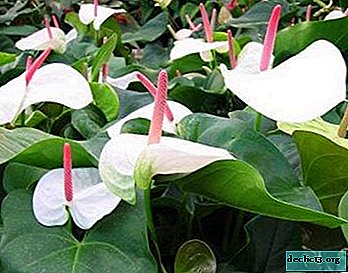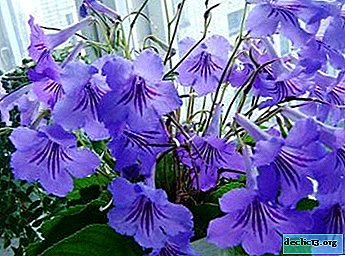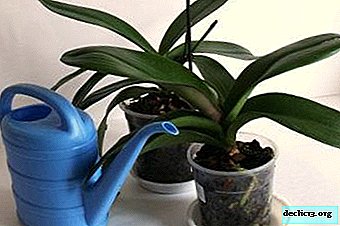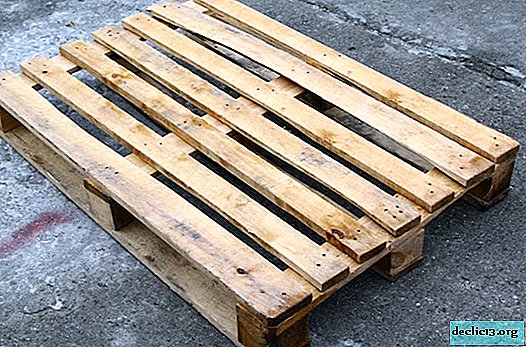Useful information for lovers of anthurium. Overview of varieties with white flowers

Dark green leathery leaves, a plant resembling a candle on a marble heart-shaped candlestick - it's all about anthurium with wonderful white flowers that looks great in both the office and the apartment.
Anthurium looks good in combination with other flowers in a bouquet. This plant is very moody, therefore, it requires special attention.
What varieties of anthurium with white flowers exist, about home care and reproduction, as well as plant diseases and pests, read in our article.
Botanical Description
The people call Anthurium "male happiness" due to beliefs related to its effect on men's health. In European countries, the name “flamingo flower” has become attached to the plant due to the red or pink color of the bract, which is characteristic of many anthuriums, but it also applies to varieties with white flowers. The Latin name - Anthurium - is derived from Greek words with the meaning of "flower" and "tail".
The Europeans were introduced to the anthurium by the French botanist and landscape architect E.F. Andre. In 1876, he made a scientific expedition to Ecuador, where he discovered a previously unknown plant and sent a copy of it to Europe.
The genus Anthurium belongs to the Aroid family. According to various estimates, it includes from 500 to more than 900 species. Most anthuriums are evergreen herbaceous plants with thick short stems. The shape and structure of the leaves vary depending on the species. Small square or rhombic flowers are collected in an inflorescence-ear with a leathery bract of various colors - from white to bright red. People far from botany usually take bract for a single flower petal. The natural habitat is from Mexico to the north of Argentina.
Plant varieties and photos with them
In indoor floriculture, the two most common types are Anthurium Andre and Anthurium Scherzer. For both of them, the red color of the bract is more typical, but there are a number of varieties of white color.Due to the large size, Anthurium Andre is often grown in greenhouses, but is suitable for home conditions. Among the most common varieties of white.
White Champion
White Champion. Variety with yellowish ears on a high peduncle. The snow-white bract is beautifully curved. Over time, a light green hue breaks through.
White Heart
White Heart. The ear of this variety is bright pink with a more intense color closer to the tip, the bract is white, pointed.
Acropolis (Acropolis)
Acropolis (Acropolis). The cob is light yellow at the base, with a bright yellow tip resembling a candle flame. The bract is snow-white, the shape approaches a round one. Large leaves are characteristic of this variety..
Polaris (North Star)
Polaris (North Star). The ear is white, with time acquires a pinkish tint. Bract - elongated, pointed, with beautiful bends - resembles a ray of a star. As it blooms, it becomes greenish.
Scherzer
Anthurium Scherzer is more suitable for rooms and offices. A distinctive feature is the cob, slightly twisted in a spiral. Among the white varieties, the most famous is Album with a white cob and a white oval bract. Scherzer Anthurium varieties are described here.
Home Care
- Temperature. Like most tropical plants, anthurium is thermophilic. In the summer, he needs a temperature of 20 to 27 ° C, in the winter-autumn period it is reduced to 15 ° C, but this should be done gradually. Draft flower does not tolerate. From mid-January, you should start raising the temperature and gradually bring it to summer.
- Watering. Anthurium, a native of rainforests, loves moisture, but does not tolerate fluid stagnation. It would be ideal if there was an aquarium near the flower. It should be watered abundantly, especially in the summer. Before watering, you need to make sure that the top layer of the soil has managed to dry, but you can not allow the complete drying of the earth in the pot. Water for irrigation should be at room temperature, you need to let it settle. Lime water should be softened.
After watering, the water from the pan must be drained.
- Shine. Anthurium does not tolerate direct sunlight. It is preferable to place it on the eastern and western windowsills. If the window faces south, the flower needs to be shaded.
- Priming. Ready-made soil for orchids is perfect for anthurium. The soil should be slightly acidic or neutral. You can prepare the mixture yourself by combining in equal proportions sheet land and peat. Some gardeners advise mixing bark with a small amount of sphagnum, peat and charcoal, as well as adding a bit of pine needles and brick chips. Earth must pass air and moisture well.
- Pruning. Pruning is necessary if the bush is too thick, or if there are discolored leaves or leaves with white spots. Do not use too large clippers. Secateurs are good.
- Cropping start from above. Dried leaves and branches, as well as bleached leaves, are removed. Cropping is performed at an angle downward.
- After trimming before healing, the plant is sprayed with water from a spray bottle.
 Top dressing. For fertilizing, liquid fertilizers are used for flowering plants. The solution should be weak (20% of the dose recommended by the manufacturer).
Top dressing. For fertilizing, liquid fertilizers are used for flowering plants. The solution should be weak (20% of the dose recommended by the manufacturer).Anthurium should be fertilized no more than once a month, otherwise the leaves will begin to grow without the formation of buds. Once every 3-4 months, you can feed the anthurium with Epsom salt in a concentration of 1-2 tablespoons per 4.5 liters of water. The solution is prepared immediately before watering. At the end of summer, feeding is gradually reduced; in the autumn-winter period, anthurium is not fed.
- Pot. The pot should fit the size of an earthen coma. In a clay pot, the soil dries faster, a plastic pot allows you to maintain the required moisture level of the substrate. It is advisable that the pot has large drainage holes. The bezel-stand on the lower edge will provide air access to the roots. In no case should you use a cache-pot.
- Transfer. Young plants are transplanted annually, then - as needed. The main criterion is that the flower has become cramped in the pot. The plant you just bought should not be transplanted - it should get used to new conditions.
- Before transplanting, a drainage layer (for example, expanded clay) is laid at the bottom of the new pot, and coconut fiber or sphagnum as the second layer.
- Next, cover the main soil.
- The plant is removed from the pot, the fragile roots are carefully cleaned of the soil (it is advisable to rinse them under running water), and check for rot.
- A healthy plant is transplanted into a prepared pot.
- Wintering. Winter for Anthurium is a period of rest. At this time, it is kept at a temperature of about 15 ° C, watered no more than once a week and is not fed.
Breeding
Anthurium is propagated by dividing the bush, seeds, shoots and cuttings.
 If dividing the bush is used, then when transplanting the flower is divided into several small bushes, which are planted in separate pots.
If dividing the bush is used, then when transplanting the flower is divided into several small bushes, which are planted in separate pots.- Seed propagation is more laborious. Seeds are taken from ripened fruits, the remains of the pulp are removed. Having disinfected the seeds in a solution of potassium permanganate, they are laid out on the surface of leaf or peat soil. For germination, a temperature of at least 22-24 ° C is required. Seeds germinate in 8-15 days. After 1.5 months, in the phase of the present leaf, a pick is made.
- For propagation, apical cuttings that root in moist sand can also be used.
- Side shoots with aerial roots are planted directly in the pot.
Diseases and Pests
Anthurium susceptible:
- Fungal diseases, such as anthracnose, septoria, as well as parasites - mealybug, thrips, aphids. For their destruction, special fungicides and insecticides are used.
- Also, at low temperature and a lack of trace elements, the leaves can curl and wrinkle.
Similar plants
- Calla, or Callas also belongs to the Aroid family. Unlike the anthurium, the wing-fly tolerates the northern climate well. In Russia, it can often be found in swamps, in ditches with standing water. The inflorescence in appearance and structure resembles anthurium, its bract is always white.
- Zantedeskia is a close relative of the calla, which had previously been included in the same genus with it. Comes from Africa.
- Callopsis, another plant from the Aroid family. A characteristic feature is a short cob.
- Anaphillum also belongs to the Aroid family. Comes from the rainforests of South India. The structure of the inflorescence is close to anthurium, but the bract has a purple color and a spiral shape.
- Spathiphyllum, another representative of the Aroid family, is very similar to anthurium. He has a larger ear, the bract is always white, with time it turns green. Originally from Central and South America, it is also found in Oceania. Like Anthurium, it is used in indoor floriculture.
Anthurium with surprisingly graceful white flowers - a great choice for a grower. A contrasting combination of several varieties looks especially impressive. If you place it next to red or orange, they will perfectly complement and emphasize the dignity of each other.

 Top dressing. For fertilizing, liquid fertilizers are used for flowering plants. The solution should be weak (20% of the dose recommended by the manufacturer).
Top dressing. For fertilizing, liquid fertilizers are used for flowering plants. The solution should be weak (20% of the dose recommended by the manufacturer). If dividing the bush is used, then when transplanting the flower is divided into several small bushes, which are planted in separate pots.
If dividing the bush is used, then when transplanting the flower is divided into several small bushes, which are planted in separate pots.















